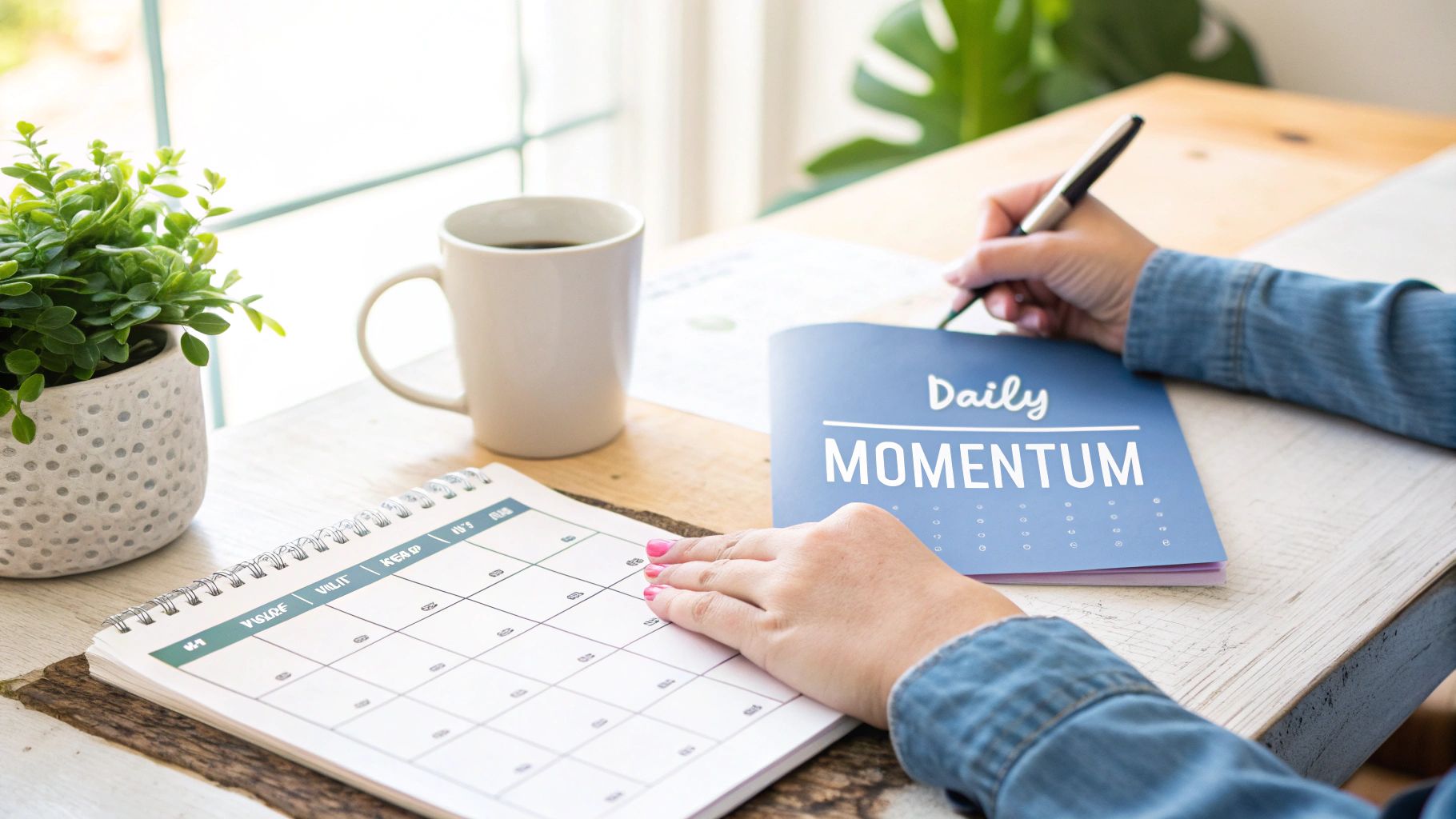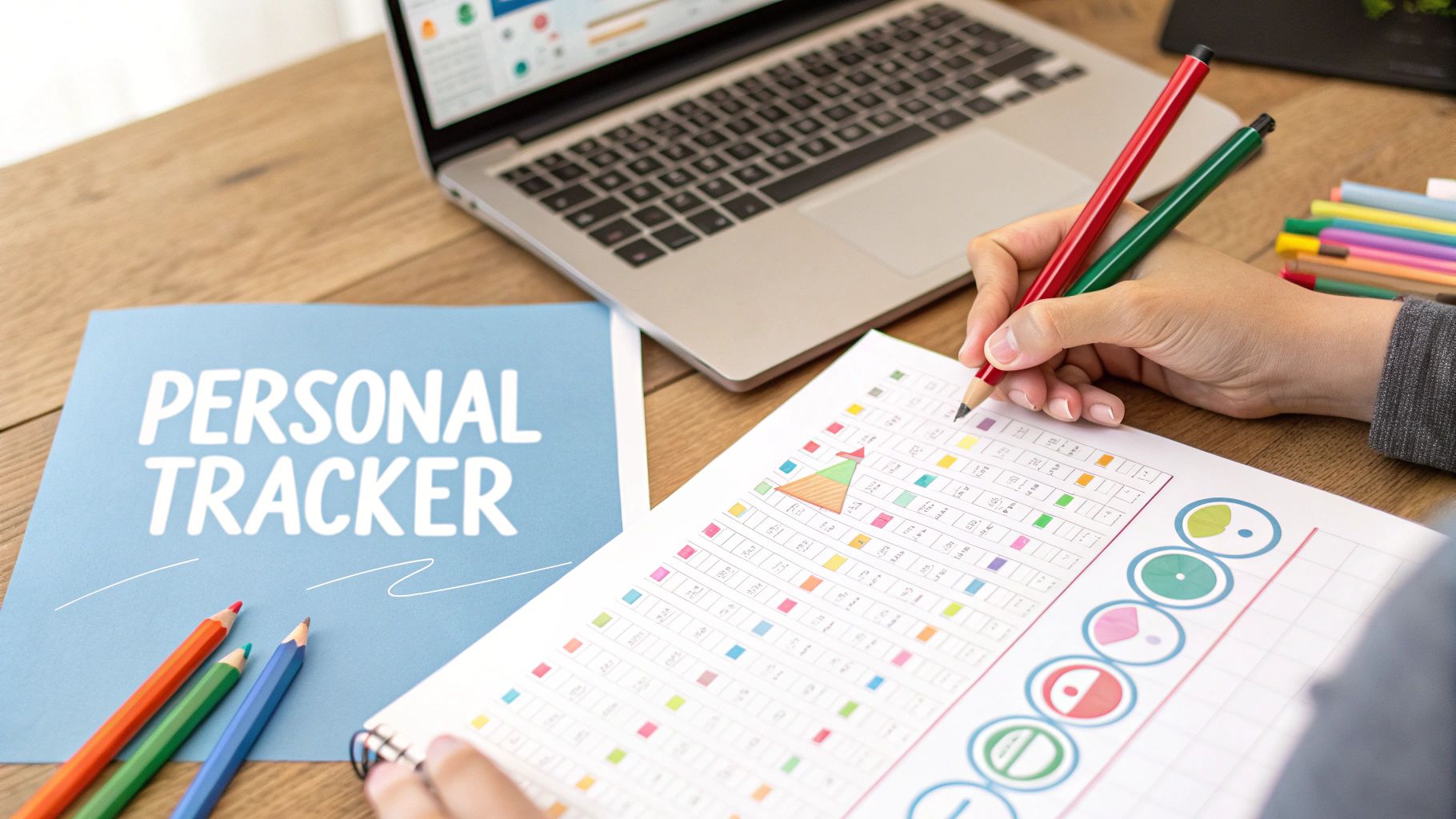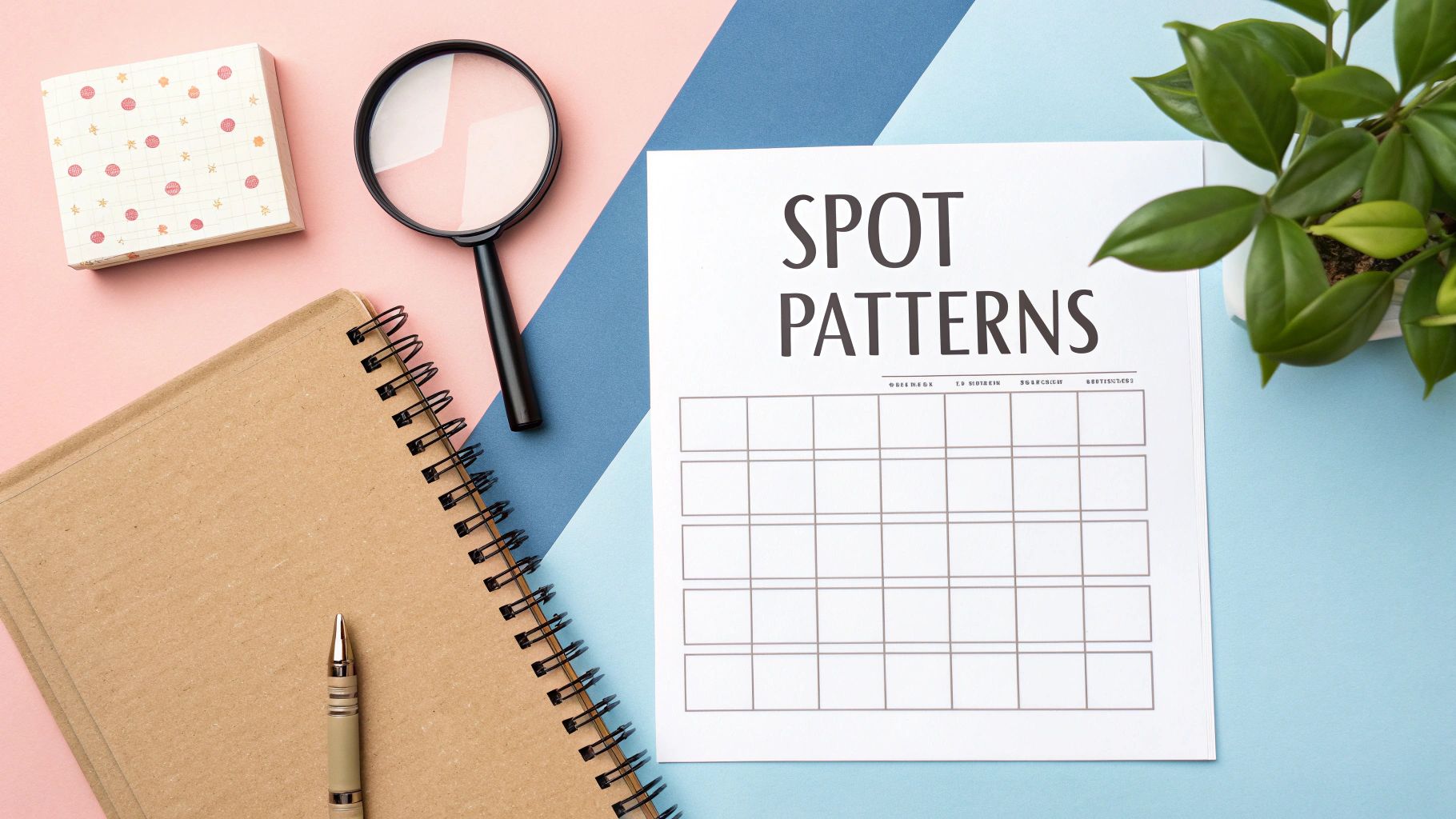Imagine ending each day with a profound sense of accomplishment, not just the exhaustion of a busy schedule. This is the transformative power of a simple daily habit tracker printable. In a world of digital noise, this humble tool can be more effective than any complex app, tapping into the psychology of momentum and making your progress tangible—something you can truly see and feel.
Why a Simple Piece of Paper Creates Powerful Change

In an age overflowing with notifications and apps, the printable tracker is making an inspiring comeback. Its greatest strength lies in its beautiful simplicity. There's a powerful mind-body connection in the physical act of putting pen to paper and checking off a box. It creates a deeply satisfying feedback loop that technology often fails to replicate.
This isn’t just about ticking off a to-do list; it’s about creating a visual testament to your commitment. Each checkmark is a small victory, releasing a tiny burst of dopamine in your brain—the neurotransmitter associated with pleasure and motivation. This reward cycle, as neuroscientists call it, reinforces the behavior and makes you eager to repeat it.
A printable tracker transforms abstract goals into a concrete, visible story of your dedication. It’s not just about tracking what you do; it’s about becoming the person you want to be, one consistent action at a time.
The Rise of Mindful Tracking
The renewed love for printable trackers is part of a larger movement toward tools that enhance both our productivity and our mental well-being. This low-tech method offers a vital break from screen fatigue, creating a quiet space for mindful reflection on your daily actions.
You’re not just tapping a screen; you’re pausing to intentionally acknowledge your effort. This simple ritual builds self-awareness and accountability far more effectively than a fleeting digital reminder ever could.
Action Point: This week, find a five-minute window each evening to fill out your tracker away from all screens. Notice how this small act of mindfulness makes you feel.
Here’s the science behind its success:
- Tangible Progress: Seeing a row of completed checks provides an undeniable visual proof of your progress, which is more motivating than a digital notification.
- Reduced Distractions: A piece of paper is a single-tasking tool. It won’t lure you into checking emails or scrolling through social media.
- Personal Connection: The act of writing reinforces your goals in your brain, making them feel more personal and significant.
This trend is evident on platforms like Etsy, where you'll find thousands of unique habit tracker designs. It’s a clear signal that people are embracing habit tracking as a core component of an intentional, balanced lifestyle. You can learn more about the growing demand for printable planners on Etsy.com.
Choosing Habits That Will Actually Transform Your Life

The quickest path to abandoning a new habit tracker is cramming it with too many ambitious goals from day one. Lasting, meaningful change begins when you select just a few powerful habits that align with your deepest aspirations. The goal is to design a tracker that inspires you, not one that feels like yet another burden.
Let's move beyond vague intentions. A goal like "get fit" is too broad and easy to dismiss. The key is to reframe it into a specific, actionable task. For instance, "get fit" becomes "do a 10-minute walk after lunch." According to Stanford professor B.J. Fogg, author of Tiny Habits, making behaviors specific and easy is crucial for success.
Start with a Simple Audit
Before you even touch pen to paper, take a quiet moment for reflection. Which areas of your life are calling for more consistency? We aren't aiming for a complete life overhaul overnight. Instead, we're searching for your keystone habits—small wins that create a positive domino effect across your entire life.
For many, a simple morning routine is the perfect place to start. One of the most effective strategies for building healthy habits that actually stick is to "stack" a new behavior onto an existing one.
A keystone habit, like making your bed each morning, isn't just about a tidy room. It’s about igniting a chain reaction of other good decisions, proving to yourself from the moment you wake up that you are capable of success.
Choose Your First Few Habits
Your initial habits should feel almost too easy. The goal is to build momentum and create a foundation of trust in yourself through small, consistent actions.
Action Point: Choose ONE keystone habit to focus on for the next seven days. Make it so small you can't say no.
Here are a few ideas to spark your imagination:
- Mindfulness: Meditate for just 3 minutes upon waking.
- Health: Drink a full glass of water before your morning coffee.
- Self-Care: Read one single page from a book before bed.
These tiny acts of self-care are proof of your ability to follow through. For more inspiration, this free downloadable self-care checklist offers wonderful ideas. Remember, the goal is progress, not perfection.
Finding and Customizing Your Perfect Tracker

You’ve chosen a few habits that genuinely excite you. Now for the fun part: finding a tracker that feels like an extension of you. A quick search for a "daily habit tracker printable" reveals endless options, from minimalist grids to detailed weekly spreads. The secret is to find one that feels inviting, not like another chore.
Think of your tracker as a trusted partner on your journey. What design will inspire you to pick up a pen and celebrate your daily win? Some people thrive on seeing a full month at a glance, feeling that big-picture accomplishment. Others find a weekly focus less overwhelming and more motivating. There is no right answer—only what’s right for you.
Much like self-esteem worksheets provide a structured path to building confidence, a great habit tracker offers a simple, visual system to cheer yourself on as you move toward your goals.
Make It Uniquely Yours
A blank template is merely a starting point. The real transformation happens when you infuse it with your personality, turning it into a powerful tool for self-discovery and growth.
Action Point: Personalize your tracker this week. Use color, add a quote, or create a small reward for consistency.
Here are a few inspiring ways to personalize your tracker:
- Color-Code Your Goals: Assign a color to each life area—green for health, blue for work, yellow for joy. This makes the page scannable and beautiful, giving you an instant visual of how you’re distributing your energy.
- Add a Mood Tracker: Simply add a space to note how you’re feeling each day—a smiley face, a single word, or a number rating. Over time, you’ll discover powerful connections between your habits and your overall mood.
- Create a Mini-Reward System: What small joy can you gift yourself for staying consistent? Perhaps a favorite coffee after 7 days of morning meditation or a new book after 30 days of journaling. Write it on your tracker as a built-in motivator!
Which Habit Tracker Style is Right for You?
With so many layouts available, it can be tough to know where to begin. This table breaks down the most popular styles to help you find your perfect match.
| Tracker Style | Best For | Key Feature |
|---|---|---|
| Monthly Grid | Visualizing long-term consistency and building streaks. | A calendar-style layout perfect for seeing an entire month of progress at a glance. Excellent for "don't break the chain" motivation. |
| Weekly Log | Focusing on daily details and short-term goals. | Offers more space for notes, mood tracking, and reflections. Ideal if you feel overwhelmed by a full month. |
| Circular/Wheel | Visual thinkers and tracking a single, keystone habit. | A unique, circular design that offers a satisfying visual as you fill it in, representing a completed cycle. |
| Minimalist List | No-fuss tracking and focusing purely on consistency. | A clean list of habits with checkboxes for each day. Straightforward, efficient, and highly effective. |
Ultimately, the best tracker is the one you are excited to use. Feel free to experiment—try one style this month and a completely different one the next!
Your tracker is a living document, not a final exam. If a layout feels more like a burden than a boost, give yourself permission to change it. The most effective system is always the one you actually stick with.
Making Your Tracker an Unbreakable Daily Ritual
A beautiful tracker is inspiring, but its true power is unleashed when it becomes a non-negotiable part of your day. A forgotten tracker tucked away in a drawer builds nothing. The goal is to weave it so seamlessly into your routine that checking it off feels as natural as brewing your morning coffee.
This is where the concept of habit stacking becomes your superpower. As detailed by James Clear in Atomic Habits, the principle is simple: link your new habit (filling out the tracker) to an established one you already perform on autopilot.
Action Point: Place your tracker and a favorite pen right next to your toothbrush or coffee machine. For the next week, fill it out immediately after that existing habit.
Imagine this: while your coffee brews, you take those sixty seconds to reflect and mark your progress. Just like that, you’ve forged an effortless new ritual.
Create an Unmissable Visual Cue
Your tracker’s location is more important than you think. Out of sight truly is out of mind. Make your commitment to yourself impossible to ignore by placing it in a high-traffic spot.
- On your bathroom mirror: A perfect prompt for a morning and evening check-in.
- Next to your computer: A gentle, constant reminder during your workday.
- On the fridge door: The kitchen is the heart of the home, making this a central hub for your goals.
This strategic placement transforms your printable from a piece of paper into a daily visual contract with yourself—a loving nudge toward the person you are becoming. Integrating this into a structured morning can be a game-changer. For more ideas, explore our guide on how to create a morning routine that sets you up for success.
Embrace progress over perfection. A missed day is not a failure—it's data. The real victory is found in consistency, not in an unbroken streak.
Don't let one empty box derail your entire journey. The real win is in picking that pen back up the very next day. This resilience is what forges lasting habits.
Turning Your Data into Genuine Growth

The true alchemy of your daily habit tracker doesn’t happen in the daily checkmarks. It’s in the story those marks tell over time. This is where a simple piece of paper evolves into a profound tool for self-discovery.
Taking just five minutes each week to review your progress is what elevates mindless tracking into intentional growth.
Approach your tracker with curiosity, not criticism. A few empty boxes are not failures; they are data points. They are clues. This weekly check-in is your opportunity to celebrate wins, understand obstacles, and make intelligent adjustments for the week ahead.
Your tracker is a mirror reflecting your efforts, not a scorecard judging them. Use it to understand yourself better, spot hidden patterns, and celebrate every single step you're taking toward your goals.
Ask Powerful Questions
To unlock the deepest insights from your review, go beyond just counting checkmarks. Ask yourself thoughtful questions that reveal the why behind your actions. This small ritual is the bridge between tracking habits and truly transforming your life.
Action Point: Schedule a 10-minute "Weekly Review" with yourself in your calendar right now. Ask these three questions:
- When was I most successful, and why? Did you nail your morning walk on the days you laid out your clothes the night before? That’s a powerful insight!
- What was my biggest obstacle? Did late meetings consistently sabotage your evening reading goal? Knowing this allows you to create a better plan, like reading for five minutes at lunch instead.
- How did these habits make me feel? Look for connections. Was your mood brighter on days you stuck with your workout? Did you feel more energized and focused?
This simple cycle of tracking, reviewing, and adjusting is incredibly powerful. Research from Dominican University of California found that you are 42% more likely to achieve your goals simply by writing them down and sharing them. Your tracker is a form of this powerful accountability. You can find more insights on the benefits of using a printable tracker from Day Designer.
The goal is to learn from your own life. If a habit feels too big, don't abandon it—shrink it. Turn "meditate for 20 minutes" into "meditate for 2 minutes." This is how your tracker becomes a dynamic, living guide on your journey to becoming your best self.
Common Questions About Habit Trackers
Embarking on a new journey with a daily habit tracker can bring up a few questions. Think of these as friendly guideposts to keep you inspired and moving forward with grace.
The most important principle is to be kind to yourself as you build these incredible new habits.
What if I Miss a Day?
First, take a deep breath. Missing a day is not a catastrophe—it’s simply data. The greatest threat to consistency is the all-or-nothing mindset that declares one slip-up a total failure.
Instead of giving in, get curious. Why did you miss it? Was the habit a bit too ambitious for now? Was your schedule unexpectedly chaotic? A tracker with a few blank spots is a sign of a real, human life, not a sign of weakness.
The most powerful rule in habit formation is to never miss twice. One missed day is an accident; two is the start of a new, unwanted habit. Simply get back on track the very next day.
How Many Habits Should I Track?
Less is profoundly more, especially at the beginning. I always recommend focusing on just 3 to 5 key habits to avoid feeling overwhelmed. This concentrated approach allows you to build true momentum without diluting your energy.
You could choose a few habits from one area of life, like health, or select one tiny habit from a few different categories to create balance.
- Health: Drink one glass of water immediately upon waking.
- Mindfulness: Stretch for two minutes before getting into bed.
- Personal Growth: Read one page of a book during your lunch break.
Once these feel effortless and automatic, you can confidently add or exchange new ones.
How Long Does It Take to Build a Habit?
You can let go of the old "21 days" myth. Research from the European Journal of Social Psychology shows that the time it takes for a new behavior to become automatic can range anywhere from 18 to 254 days.
The timeline depends entirely on you, the complexity of the habit, and the context of your life. Shift your focus from the destination to the journey—the simple, powerful act of showing up today. The real goal is consistent progress, not hitting some imaginary finish line.
Ready to begin your journey of intentional growth and self-discovery? Mesmos offers beautifully designed tools and printables that inspire mindfulness and help you build habits that last a lifetime. Explore our collection and find your perfect accountability partner today at https://mesmos.co.
